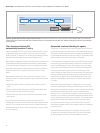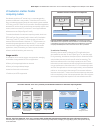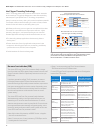25
White Paper: The All New 2010 Intel® Core™ vPro™ Processor Family: Intelligence that Adapts to Your Needs
Simplify and speed up activation
The all new 2010 Intel Core vPro processor family allows secure, remote
access and management of PCs even if the OS is inoperable, PC power
is off, a hard drive has failed, or the PC is outside the corporate firewall.
To maintain the proper level of security for these capabilities, it is impor-
tant that IT administrators establish the security credentials for Intel
vPro technology appropriately for activation in their service environment
before configuring Intel vPro technology for remote management.
IT administrators can choose the level of security and automation
appropriate for their network environments.
General activation process
Activating Intel vPro technology in a PC with a new Intel Core vPro
processor generally follows three steps: setup, configuration, and
integration. Setup establishes the initial security credentials required
for secure communication between the setup-and-configuration appli-
cation (SCA) and Intel Active Management Technology (Intel AMT) on
the target PC. (Intel AMT is part of Intel vPro technology.) Setup also
establishes the initial network and operational parameters required
to begin configuration.
Configuration is a self-initiated, automated step that depends on
security credentials being in place. Integration means discovering
and integrating a new Intel Core vPro processor-based PC into the
management application. Once these steps are complete, Intel
vPro technology is activated, and IT administrators can start
taking advantage of the built-in intelligent security and remote
manageability capabilities.
Methods to establish security credentials
A new Intel Core vPro processor supports different processes for
setting up security credentials on the PC and management console.
These processes allow IT to select the security level appropriate for
their environment:
• One-touch manual: Manually enter key pairs into the PC and the
management console.
• One-touch USB key: Keys can be generated on the management
console and stored on a USB key. The USB key is then used to install
the keys onto the PCs.
• Remote configuration: Setup of initial security credentials occurs
automatically (the PC must be configured by the original equipment
manufacturer (OEM) for remote configuration). Remote configuration
requires a provisioning service, typically called a setup and configu-
ration application (SCA). An SCA is required for both standard and
advanced provisioning.
Activation models
A new Intel Core vPro processor supports three configuration
models to allow for flexible activation:
• Basic configuration refers to a manual provisioning method
useful for small businesses. This configuration method uses
HTTP Digest for user authentication. There is no encryption
applied to management traffic.
• Standard configuration provides enough security for most corpora-
tions. Client authentication is based on HTTP Digest, which requires
a username and password. There is no encryption applied to
management traffic.
• Advanced configuration provides the highest level of security
features. This model allows IT to configure the PCs to use network
access control standards such as 802.1x, Cisco SDN, and Microsoft
NAP. This model also allows IT to configure the management traffic
to be encrypted with TLS or mutual TLS. In addition, authentication
can be managed by the Microsoft Active Directory* via Kerberos. PCs
with a new Intel Core vPro processor allow IT to remotely config-
ure these security options. Note that not all management console
vendors provide support to configure all security options.
Ready for the future
Laptop and desktop PCs with a new Intel Core vPro processor help
manufacturers deliver stable, standardized PCs. These PCs have with
broad industry support and are ready for the heavily multithreaded OSs
and applications of the future.
• 64-bit multi-core processor: PCs with a new 2010 Intel Core vPro
processor handle today’s OSs, and are ready for Windows 7, a heavily
threaded architecture. Get the intelligent performance you need for
Windows 7 when your business is ready to migrate.
• Performance for multi-threaded Office applications: New
2010 Intel Core vPro processors provide the performance needed
for Microsoft Office 2007, including the adaptable performance
for intense, always-on (by default) text-based search indexing,
which is heavily multithreaded.
• 64-bit graphics support: PCs with a new 2010 Intel Core vPro
processor have built-in 64-bit graphics for an outstanding Windows 7
Aero* experience. There is no need for a discrete graphics card with
these laptop or desktop PCs.
• Upgrade to Windows 7 quickly, remotely, and overnight without
losing access to your legacy applications, and save up to 40 minutes
of end-user productivity per user with a new 2010 Intel Core
vPro processor-based PC.
5
• Support for legacy applications via Windows 7: IT can take advan-
tage of hardware-assisted virtualization through Intel VT, to improve
performance for users running a legacy OS (such as Windows XP) in
Windows 7.


















